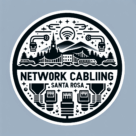Are LAN Cables Waterproof? Everything You Need to Know About Weatherproof Network Wiring
When a standard Ethernet cable gets wet, several issues can occur:
- Corrosion: Water causes oxidation of the copper conductors, degrading performance over time.
- Signal interference: Moisture can alter the electrical properties of the cable, leading to slower speeds or disconnections.
- Short circuits: In extreme cases, water entering connectors or cable joints can cause shorting or permanent damage.
- Network instability: Intermittent drops or speed issues are common when cables are exposed to humidity.
Even minor water exposure can cause long-term reliability problems, so proper cable selection and installation are key. Our team of network cabling professionals in Santa Rosa ensures that every installation meets performance and environmental protection standards.
How to Protect LAN Cables from Water Damage
If your network setup requires running Ethernet outdoors or near moisture, here are a few best practices to keep it safe:
- Use outdoor-rated or waterproof cables.
Choose Cat6 or Cat6a cables with PE (polyethylene) or UV-resistant jackets. - Run cables through conduit.
Use PVC or flexible conduit to shield from direct rain or sprinkler exposure. - Seal connectors and junctions.
Apply waterproof boots or self-fusing silicone tape at the ends of connectors. - Avoid low-lying or flood-prone areas.
If possible, elevate or reroute cables to avoid standing water. - Use weatherproof junction boxes.
Protect termination points, PoE injectors, or switches from rain and moisture.
These simple precautions help extend the lifespan of your cables and keep your network running smoothly.
Indoor vs. Outdoor LAN Cable Differences
| Feature | Indoor Ethernet Cable | Outdoor / Waterproof Ethernet Cable |
|---|---|---|
| Jacket Material | PVC (not water-resistant) | PE or UV-resistant polyurethane |
| Moisture Resistance | Low | High |
| UV Protection | None | Yes |
| Temperature Tolerance | Standard (0–60°C) | Extreme (-40°C to 75°C) |
| Use Case | Offices, homes, indoor networks | Outdoor cameras, Wi-Fi, industrial areas |
If you’re unsure which to choose, remember: if it’s outdoors or near moisture, use outdoor-rated LAN cable.
Where to Use Waterproof LAN Cables
Waterproof LAN cables are ideal for:
- Outdoor security cameras and CCTV systems
- Backyard or parking lot Wi-Fi setups
- Inter-building connections on campuses or business parks
- Warehouse or industrial facilities
- Marine and coastal environments where humidity is high
These cables help maintain network stability even in challenging weather conditions.
Should You Bury LAN Cables Underground?
Yes, you can — but only with direct burial Ethernet cables. These cables have an extra protective layer or gel that blocks moisture. Always:
- Use conduit where possible for added protection.
- Keep the burial depth at least 6–12 inches.
- Avoid running parallel to power lines to reduce interference.
When installed correctly, direct burial cables can last 10 to 15 years underground without major issues.
Final Thoughts
So, are LAN cables waterproof? Not by default. However, with the right outdoor-rated or waterproof Ethernet cable, you can safely extend your network outdoors, connect buildings, or power outdoor cameras without worrying about moisture damage.
Always choose cables labeled for outdoor or direct burial use, follow installation best practices, and consult a licensed low-voltage professional for large or critical projects. Different types of LAN cables offer varying levels of protection and performance. You can learn more about the five main networking cable categories to understand which ones are best for your environment.
With proper planning, your LAN cables can handle California’s weather — rain or shine — while keeping your network fast, stable, and secure.
